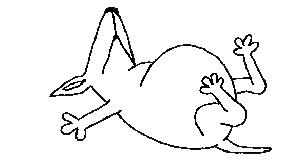PART
![]()
of your

GUIDED
PART
![]()
of your

GUIDED
TOUR OF
COLCHESTER
The Dutch Quarter The Taylor Family The Stockwell Arms St Martins Church Architectural Oddity Timber Framed Building Our First Public Library Town Hall
We continue our tour having started at the war memorial, taking a walk around the castle and its park and then passing into the Dutch Quarter.
We are at the Stockwell Chapel in East Stockwell Street (once named Bear Lane because of the tavern by that name that once stood in the High Street).
~~~~~~~~~~~~~~~~~~
Before we set off, here's a little bit more about our earlier Romano-British history, so that you can fit in the places and buildings that we'll see with the events that produced them.
The Romans conquered Britain in AD 43, taking the surrender (allegedly) of eleven tribal chiefs, at a place called Camulodunum. The colonia that was built on the hill where we now are was first built as a fortress to keep an eye on the wily British, but which soon evolved as a colonia. Colonias were settlements where retiring Roman soldiers could live, loyal to the empire, with extensive amounts of land, previously belonging to the British, being conferred upon them. This would have led to considerable ill feeling amongst the indiginous race, who must have faced up to the situation and adopted the new Roman way of life, perhaps biding their time until they could rise up and take back what was rightfully theirs.
1
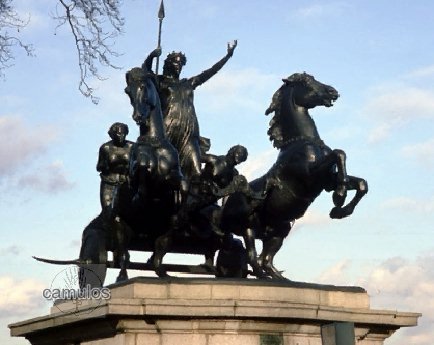
After the sacking of the town by Boadicea and her followers, where the ancient historian Tacitus tells us that 30,000 Romans and their followers were slaughtered (that number including Londinium, Verulamium, etc, as well), work was commenced on building the 2800 metre long defensive wall - of which later. Today, whenever an archaeological dig is made within our walls, a black burnt layer is usually discovered which enables precise dating to AD 60/61. The roman wall has its own Camulos web page. Please go there for more information.
~~~~~~~~~~~~~~~~~~~~~~
2
Looking north on East Stockwell Street. We now turn back and walk south, up the hill and take a right turn through Quaker Alley, alongside St Martin's church.
3
Looking south on East Stockwell Street. The building in the centre of the picture was built as a school for St Martins church, now a private residence - at one time a Member of Parliament, who claimed it to be his main residence in the 2000s - and did very nicely from expenses as a result, until he was caught out.
As we have previously mentioned, the area that we are now in is part of what we know as our Dutch Quarter, more correctly, the place where the Flemish settlers, known as Hugeonots, came in the 16th century, to avoid religious persecution in their own country, by their Spanish led Catholic rulers. Indeed, Colchester at that time had only recently been recovering from the 23 martyrs, burned at the stake as heretics, in the town under the Catholic persecution of Queen Mary. It was Elizabeth who succeeded her sister and returned England to protestantism that her father Henry 8th had introduced. Colchester was indeed caught up with this religious turmoil, and the Dutch Quarter (as we know it today) was very much an area of the town that was associated with non-conformism (opposition to Henry's Church of England).
In 1565, Queen Elizabeth I gave her approval to the first of eleven families, a total of 55 people (refugees by another name), coming to Colchester to live. By 1586, they totalled 1291 people, making up a large proportion of the town's population of around 10,000. The Flemish were principally weavers who brought great wealth and prosperity to the town, making Colchester, for a period, one of the most important wool towns in England. Look around you as you wander this area to the north of High Street, around what was then Bear Lane, Angel Lane, Maidenburgh Street, before the Victorian political correctness types renamed these streets. We have the Colchester Civic Society to thank for helping to prevent the destruction, in the 1950s, of the houses that were built by these Flemish people, so many centuries before. Today, some 60 of these houses survive, those still owned by the borough being distinguishable by the red and green colour of walls and woodwork.
Earlier than this, the area was the Jewish Quarter, where their much hated but very necessary trade of money lending (usury) was carried out. However, in 1290, the Jews were expelled from the country, not to be allowed to return, until Cromwell's time, in the mid 17th century.
4
These medieval houses in East Stockwell Street have large downstairs windows; essential for weavers who needed to be able to see what they were doing, whilst being able to work at their looms and pass the time of day with passers-by.
5
6
We are now in West Stockwell Street (once named Angel Lane because of the tavern by that name that once stood in the High Street). Crossing the road and looking back towards where we have been, we see to the left a pair of old houses with a plaque on the wall. This was the house where the Reverend Isaac Taylor and his family once lived at the end of the 18th century. The family were engaged in the engraving trade as well as their links with Stockwell Chapel. Isaac had two talented daughters, Jane and Ann Taylor who wrote stories for children. Jane Taylor has been immortalised by one of her nursery rhymes that, inspired by the view of the night sky, she is alleged to have written in the attic room of this house. The rhyme goes:
Twinkle, Twinkle Little Star,
How I wonder what you are,
up above the world so high,
like a diamond in the sky.......
7
At the foot of the hill is the Stockwell Arms, a fine example of an early timber framed building whose deeds date back to at least 1380 and where the famous 18th century writer, Daniel Defoe, once lived. He based his book, Moll Flanders, on the life of a girl from Mile End in Colchester. His most famous novel perhaps being Robinson Crusoe, possibly written in Colchester.
(There is more information about this pub in the 'Inns, Taverns and Pubs of Colchester' page.)
8
St Martins church, in the heart of our Dutch Quarter, was badly damaged by cannonfire during the Civil War of 1648, and has recently been restored by the Churches Conservation Trust. It is in a mixture of many architectural and ecclesiastic styles and makes much use of reclaimed Roman materials. It is one of six surviving medieval churches within the walls of the town; the others being: All Saints, Holy Trinity, St James the Great, St Mary at the Walls, St Peters - with St Giles and St Leonard outside the walls. St Nicholas and St Runwalds churches were demolished many years ago. But more of these later!
The churchyard gates are open and we have the key to enter the church itself so, let's start by looking at the only known gravestone of a bay maker in Colchester. This is a testament to a past industry, when Colchester was one of the biggest and wealthiest wool trade towns in England. Jacob Ringer would most probably have been of Flemish descent.
The cloth known as bays and says exist in modern form today as the green baise (baize) covering for snooker tables.
9
The original inscription is now virtually illegible. This plaque is a modern addition. We now enter the church, now redundant, empty and looking for a good use.
10
There is much evidence of medieval wall paintings, tantalisingly uncovered in various areas, to give an insight to how it once must have looked. These paintings were whitewashed or destroyed, censorship in antiquity, by puritanical thinking of the time.
11
The following picture is of the 'squint' (hagioscope, leper's squint, whatever), a feature believed to have been used for simple folk to observe the mysteries of the mass - or perhaps to enable lepers to observe without mixing with their fellow men and women.
12
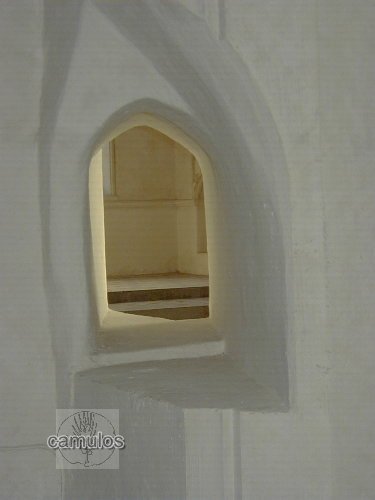
13
Having left St Martins and moved south up the hill of West Stockwell Street and in to the High Street, we pass on the left a fine example of Queen Anne period architecture - but with a difference! The architect, a Colchester man named James Deane, would probably have suffered a seizure to see what a horrible non-symmetrical addition had been made to his design. Whilst it has been done well, it is very out of keeping with the style of that period.
James Deane designed the west wing of Hollytrees for Charles Gray, the saviour of our castle, as well as other important buildings within the town.

14
Further uphill, and to the left, opposite the little graveyard that once belonged to St Runwald's church that once stood in the High Street, is a fine example of a 17th century timber framed building. Don't let anybody tell you that this was the Angel Inn. The Angel Inn stood at the top of the hill, on the corner with High Street. This building has carved angels as part of its elaborate frontage, but these would have been to ward off evil rather than an indicator of the name of the house. A firm of solicitors now occupy the property, which would once have been the home of a wealthy personage. Evidence along the front indicates that the ground floor served as a shop at some time.
We now walk to the top of West Stockwell Street, passing Colchester's first public library building, now part of the Town Hall.
COLCHESTER' S FIRST PUBLIC LIBRARY Attached to the town hall is a Victorian building in Jacobean style that was originally built as Colchester's first public library in 1893. Its construction followed a very convenient fire that engulfed the original Blue Boar public house, that stood on that site. As the need for a bigger premises came about, it was later to become the refectory for council employees. We show some pictures of the inside of this magnificent building below.
15
16
17
The interior has been decorated by items from the corporation's art collection. Note the 'queen post' style roof. The windows overlook Stockwell Street West, previously Angel Lane.
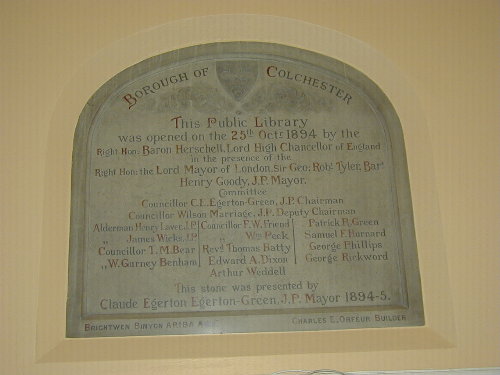
The above picture tells us that the library was opened on the 25th October 1894 by both the Lord High Chancellor of England in the presence of the Lord Mayor of London and the Mayor of Colchester, Henry Goody, as well as other civic dignitaries.
19 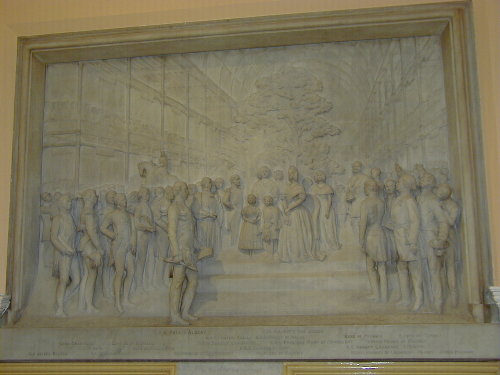
This fine bas relief sculpture also adorns the walls, although its significance is unknow to us. It depicts Queen Victoria, her beloved Albert and their family.
So, back into the oldest High Street in Britain, to have a look at our magnificent Town Hall.
20
We have now arrived in the High Street where our magnificent Town Hall stands in all its Victorian splendour. Finally opened in 1902, it is decorated with many fine carvings, some of which are worthy of comment. Of course, at the very top, is St Helena, facing Jerusalem. In fact, she was originally an 'off the shelf' Madonna and child statue from Italy, but her baby was taken from her for her new role. Below her are four ravens, emblems of the Port Reeve, an indication of the past importance of the Hythe docks area, now (sadly) something of the past. Along the front face we find statues of:
KING EDWARD
It was Edward the Elder who is recorded as having rid Colchester of the Danish invaders, the records telling us that they escaped over the town's walls.
BOADICEA
Boadicea is recorded for the destruction that she brought to the Roman colonia but also as a hero of the ancient British people.
BISHOP HARSNETT
21
Bishop Harsnett was the son of a Colchester baker, becoming a master at Colchester Grammar School. However, teaching did not suit him and he became a cleric, rising up to become Archbishop of York. He left his extensive collection of books to the borough, known as the Harsnett Library, although sadly, public access is not permitted due to a lack of facilities.
WILLIAM GILBERD
22
William Gilberd was the son of a Recorder of Colchester and became the most eminent English man of science of his day. He made the important discovery of electromagnetics, carrying out some very important early studies on this subject and was the first to use the word 'electricity'. He was also physician to the court of Queen Elizabeth I. Part of his huge house survives today as Tymperleys in Holy Trinity parish, of which more later.
THOMAS AUDLEY
23
Lord Thomas Audley was Colchester's Town Clerk for a period but went on to become Lord Chancellor in King Henry VIII's time, being instrumental with laws concerning the dissolution of the monasteries and the king's marital difficulties. His family came from Colchester and a substantial number of memorials to the family exist in a chapel at nearby Berechurch.
EUDO DAPIFER
24
Eudo Dapifer (or Eudo de Rie) was steward to William the Conqueror who conquered England by defeating King Harold in 1066. Eudo built the castle in the latter half of the 11th century, but was also great benefactor to the church. He founded St John's Abbey, the leper hospital and church of St Mary Magdalen and had St Helena's Chapel restored.
As we step inside the building to have a look around, one of the first points of interest is the 'Roll of the Fallen' board on the left, which lists the names of over 1500 casualties that gave their lives in battle during the first and second world wars.
More information about these men, and some women, can be found in our Colchester Heroes page.
25 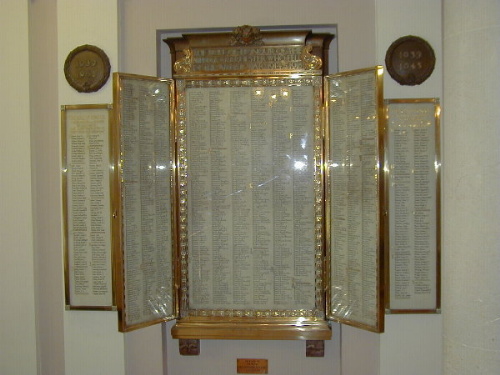
Up the grand stairs we are met half way by a statue to Queen Victoria (not wearing a wedding ring), with an incredible stained glass window behind her.
26
27
The above picture is a view inside the council chambers, where our borough councillors meet for their deliberations over Colchester matters. The chairman's chair has an older form of our borough crest, from a time when there was religious intolerance and great suspicion of Catholics. On the wall behind is a painting that depicts Sir William Gilberd, the father of electricity, making a presentation to Queen Elizabeth I around the year 1600.
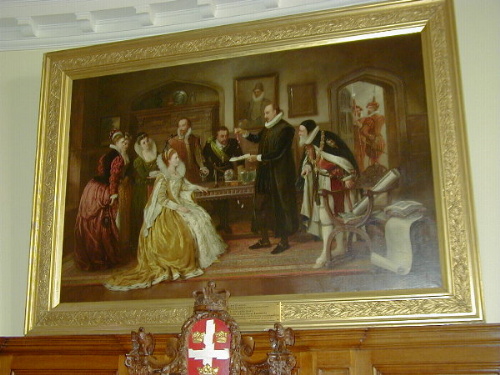
A closer view of the picture is shown above.
29 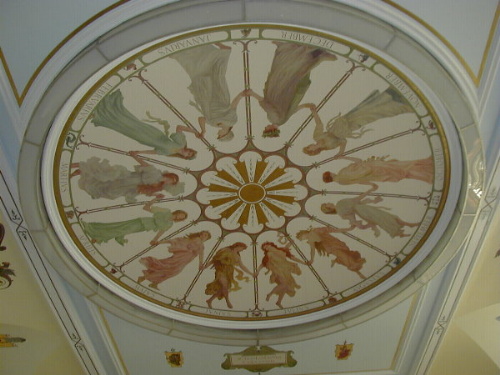
The interior of the council chamber is sumptuously decorated with the above view of the ceiling showing twelve pre-Raphaelite ladies to represent a year. The twelve months of the year are clearly written beneath each of the women.
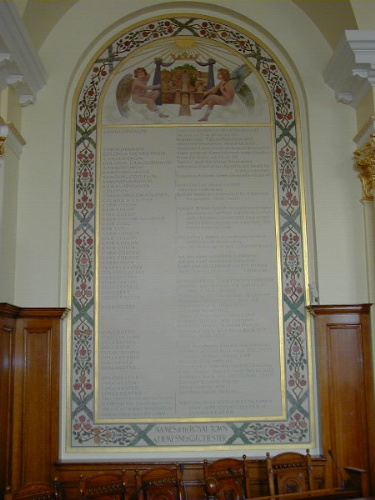
This panel details the historical evolution of Colchester's name, from the earliest times, when it was known as Camulodunum.
Camulodunum dates to celtic times and meant, fortress of the ward god Camulos. As the Romans left and the 'Dark Ages' came, the name gradually morphed into 'Colne Ceastre', a reference to colonia (not the river) and the latin word for fortress. This soon settled down as Colchester. As we all know, any place with 'chester' in its name, was a Roman place. Manchester, Chichester, Chester, etc. Lincoln still bears a clue to it once being a Roman colonia, one of only five in Roman Britain.
![]()
The council chamber decorative artists were a father and son team. Charles Edward and Charles Henry Baskett are both highly regarded in the art world and one can find examples of their work in the Victoria and Albert Museum in London. Charles Henry is famed for his aquatints and etchings and was commissioned to submit two etchings for Queen Mary's Dolls House, now housed in Windsor Castle. They were very much local people. We are grateful to Alexandra O'Grady for this information as they were her great-great-grandfather and great-grandfather respectively and the beautiful young girls each side of the painted shield on the wall, high above the bench in the Council Chamber, are both her great-aunt Christobell, Charles Henry's daughter.
That's living history for you!
31 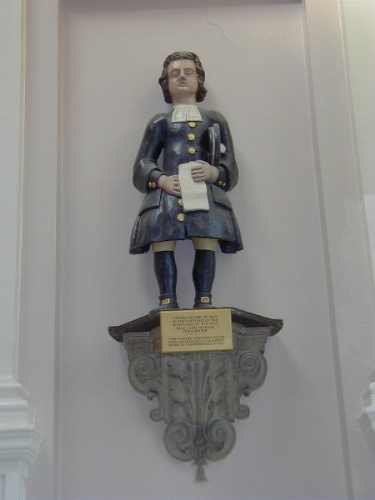
At the top of the staircase, we come to the Moot Hall, where large events, such as the Colchester Oyster Feast, are held. At either side of the entrance door, are these two statues, which, it is believed came from the town's Bluecoat School that once dispensed education to the young in St Helens Lane in our Dutch Quarter (discussed in part A of our tour). They were rescued and placed here. One would assume that they were placed separately over the girls and the boys entrances to the school, to ensure that there was no contact between the sexes.
32
33
This lavish monument records the martyrdom of those men and women of Colchester who who were put to death because of their religious beliefs, mainly at the behest of Queen Mary in the 16th century.
BAck out onto the street, we will end this part of our tour and go along the High Street to the East, for a look at two ancient inns. ~~~~~~~~~~~~~~~~~~~
Please proceed to the next stage of your Virtual Tour by clicking on
or
or return to the
Home Page
last updated
311021
